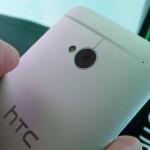HTC has added a new model in its “One” series of devices it launched last year, this one aiming to be more than just a me-too product, and adding in a metal body, high resolution screen, and some impressive camera smarts that compares more to compact cameras than the common smartphone.
Shown officially in Australia this week for the first time, the HTC One is a different beast from what we’ve seen from the company in prior years.
There’s no letter separating the versions here, like last year’s releases in the One X, XL, S, or V, with HTC instead suggesting that yes, this is the “one,” so to speak.
And what a One it’s looking to be.
The body of the 2013 One is made entirely of metal, something HTC used to do in some of its handsets, but not all. Rather than take on the design of a brick or even lipped-design that previous handsets have had, the new One has a softer look to it with a curve to the back that is designed to sit in your hand.
At its thinnest, the device manages to be only 4mm, while the thickest point is 9.3mm, the depth changing with the curvature of the body.
For the screen, HTC have managed to have the highest quality display for a smartphone in the Australian market, with a 4.7 inch Full HD screen with roughly 468 pixels per inch packed in, making it the sharpest screen yet in a mobile phone.
In fact, between the 440ppi we saw in the Sony Xperia Z this week and the 468ppi in HTC’s 2013 One, Apple’s idea of “Retina” class screens is more or less busted, especially since the iPhone 4S had a maximum of 330ppi, and the iPhone 5 is just slightly below that.
Inside the handset, HTC has a new chip, the quad-core Snapdragon 600 clocked at 1.7GHz, 2GB RAM, and a choice of either 32 or 64GB storage, though we don’t think there’s a microSD slot here, similar to the HTC One X and XL.
Access to 4G is included too, and the phone can also jump onto WiFi over 802.11a/b/g/n and even that new fandangled 802.11 ac standard, not to mention Bluetooth 4.0 with support for the high-end audio AptX technology.
The camera is all new, too, and is sure to raise some eyebrows, with a completely new imaging sensor that uses – according to HTC – “UltraPixels.”
Jargon aside, the easiest way to translate this is that the new technology uses a camera sensor that is bigger than most smartphones. While only four megapixels, HTC is betting that these four megapixels will be better than the 8 or 13 other flagship phones are offering this year.

Couple that with a reasonably low-light f/2.0 lens, optical image stabilisation in video, and a whole host of neat additions to the camera and image editing – such as easily being able to edit parts of a background photo out and producing a simple memories video in under 30 seconds with a “highlight” feature – and you see that HTC is trying to make the new One a multimedia powerhouse.
And then there’s infrared, which is making an appearance here too. With this feature, the HTC One can apparently access some form of an Electronic Program Guide (EPG) and switch programs on your home television.
Sound is also designed to be better here than competing brands, and while we expect the Beats Audio technology (and it’s here), we didn’t expect the inclusion of some loud speaker technology, which the one includes from two front stereo speakers.
Some neat changes have happened on the operating system front, with Sense 5 – HTC’s Android overlay – running on Android 4.1.2 “Jelly Bean,” not the very latest edition of Android that the Nexus 4 has, but still looks good, altogether, and features a neat homescreen news feed and social networking tracker that looks very similar to RSS magazine app Flipboard.
Indeed, this handset is looking to impress, and with 2013 shaping up to be an impressive year for mobiles, it could well do that.
HTC have pointed out that every major carrier will be selling the One shortly, though neither Telstra, Optus, or Vodafone have chimed in yet to say exactly what the pricing or availability will be like.
























The camera tech I’m sure works well. Larger pixels but far less of them apparently lets more light in and improves image quality in low light situations. When cropping & enlarging this tech looses out against denser pixelated images from what I have read. We’ll see when this smartphone is fully reviewed.
On another site we’re told this phone was voted the best at the recent WMC, beating out the Sony Xperia Z by a small margin.
I currently have an HTC titan 4G (16 megapixel camera) running Windows 7.5. Great phone & superb image quality, but I’m now rather keen to try an Android phone for the first time. In another post on this site I suggested the Sony Xperia ZL would be the weapon of choice but getting one is going to be difficult.
The HTC ‘one’ is now the clear winner. I believe it will sell in Australia outright for just under $750, basically the same as the Xperia Z from Sony.
So looking forward to getting one of these. Just wish it came in 8x blue. I personally can’t see the Galaxy S4 improving on HTC’s specs.